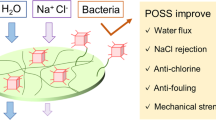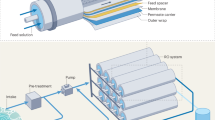Abstract
Due to an increase in the number and severity of water shortages worldwide, reverse osmosis (RO) membrane technologies are widely used for seawater desalination and wastewater reclamation. There are increasing demands for enhancing the water production rate and solute rejection rate to obtain higher quality water by consuming less energy. Therefore, it is necessary to understand the nanoscale structure and permeation mechanism of RO membranes. Typical RO membranes have a composite structure, with an ultrathin separation functional layer of cross-linked fully aromatic polyamide. The functional layer has sub-μm sized protuberance structures and sub-nm sized water channels. The protuberance structures were quantitatively examined by advanced TEM techniques. The relationship between the membrane performance and morphological parameters of protuberance structures was revealed. Hydrated structures are formed by the complex intermolecular interactions between polymers and water molecules. The structure was investigated by neutron scattering measurements and molecular dynamics simulations. In the water-rich polyamide/water system, water molecules are well connected to each other to form water channels. Based on the above results, innovative RO membranes are being developed through the precise control of nanostructures.
This is a preview of subscription content, access via your institution
Access options
Subscribe to this journal
Receive 12 print issues and online access
$259.00 per year
only $21.58 per issue
Buy this article
- Purchase on Springer Link
- Instant access to full article PDF
Prices may be subject to local taxes which are calculated during checkout







Similar content being viewed by others
References
Kurihara M, Ito Y. Sustainable seawater reverse osmosis desalination as green desalination in the 21st century. J Membr Sci Res. 2020;6:20–9.
Loeb S, Sourirajan S. Sea Water Demineralization by Means of an Osmotic Membrane. In: Saline water conversion II. Vol. 38. Washington D.C.: American Chemical Society; 1963. p. 117–32.
Cadotte JE. Evolution of Composite Reverse Osmosis Membranes. In: Materials science of synthetic membranes. Vol. 269. Washington D.C.: American Chemical Society; 1985. p. 273–94.
Kurihara M, Sasaki T, Nakatsuji K, Kimura M, Henmi M. Low pressure SWRO membrane for desalination in the Mega-ton Water System. Desalination. 2015;368:135–9.
Lin L, Lopez R, Ramon GZ, Coronell O. Investigating the void structure of the polyamide active layers of thin-film composite membranes. J Membr Sci. 2016;497:365–76.
Kurihara M, Hanakawa M. Mega-ton water system: Japanese national research and development project on seawater desalination and wastewater reclamation. Desalination. 2013;308:131–137.
Song X, Smith JW, Kim J, Zaluzec NJ, Chen W, An H, et al. Unraveling the morphology–function relationships of polyamide membranes using quantitative electron tomography. ACS Appl Mater Interfaces. 2019;11:8517–26.
Petersen RJ. Composite reverse osmosis and nanofiltration membranes. J Memb Sci. 1993;83:81–150.
Matthews TD, Yan H, Cahill DG, Coronell O, Mariñas BJ. Growth dynamics of interfacially polymerized polyamide layers by diffuse reflectance spectroscopy and Rutherford backscattering spectrometry. J Membr Sci. 2013;429:71–80.
Freger V. Kinetics of film formation by interfacial polycondensation. Langmuir. 2005;21:1884–94.
Behera S, Suresh AK. Kinetics of interfacial polycondensation reactions—development of a new method and its validation. Polymers. 2017;127:28–44.
Nowbahar A, Mansard V, Mecca JM, Paul M, Arrowood T, Squires TM. Measuring interfacial polymerization kinetics using microfluidic interferometry. J Am Chem Soc. 2018;140:3173–6.
Tomioka H, Henmi M, Nakatsuji K, Kurihara M. High boron removal seawater RO membrane. in: Proceedings of 4th international membrane conference. 2007.
Kawakami T, Nakada M, Shimura H, Okada K, Kimura M. Hydration structure of reverse osmosis membranes studied via neutron scattering and atomistic molecular simulation. Polym J. 2018;50:327–36.
Surblys D, Yamada T, Thomsen B, Kawakami T, Shigemoto I, Okabe J, et al. Amide A band is a fingerprint for water dynamics in reverse osmosis polyamide membranes. J Memb Sci. 2020;596:117705.
Movement of water molecules in reverse osmosis membranes was elucidated. Press release by Toray Industries, Inc. 2016. (in Japanese). https://cs2.toray.co.jp/news/toray/newsrrs01.nsf/0/13ECA84A5EC207EF49258045001B550B?open. Accessed 15 Oct 2021.
Robeson LM. The upper bound revisited. J Memb Sci. 2008;320:390–400.
Yang Z, Guo H, Tang CY. The upper bound of thin-film composite (TFC) polyamide membranes for desalination. J Membr Sci. 2019;590:117297.
Lim YJ, Goh K, Kurihara M, Wang R. Seawater desalination by reverse osmosis: current development and future challenges in membrane fabrication—a review. J Membr Sci. 2021;629:119292.
Shen Y, Saboe PO, Sines IT, Erbakan M, Kumar M. Biomimetic membranes: a review. J Memb Sci. 2014;454:359–81.
Henmi M, Nakatsuji K, Ichikawa T, Tomioka H, Sakamoto T, Yoshio M, et al. Self-organized liquid-crystalline nanostructured membranes for water treatment: selective permeation of ions. Adv Mater. 2012;24:2238–41.
Sakamoto T, Ogawa T, Nada H, Nakatsuji K, Mitani M, Soberats B, et al. Development of nanostructured water treatment membranes based on thermotropic liquid crystals: molecular design of sub-nanoporous materials. Adv Sci. 2018;5:1700405.
Watanabe R, Sakamoto T, Yamazoe K, Miyawaki J, Kato T, Harada Y. Ion selectivity of water molecules in subnanoporous liquid‐crystalline water‐treatment membranes: a structural study of hydrogen bonding. Angew Chem Int Ed. 2020;59:23461–5.
Author information
Authors and Affiliations
Corresponding author
Ethics declarations
Conflict of interest
The author declares no competing interests.
Additional information
Publisher’s note Springer Nature remains neutral with regard to jurisdictional claims in published maps and institutional affiliations.
Rights and permissions
About this article
Cite this article
Shimura, H. Development of an advanced reverse osmosis membrane based on detailed nanostructure analysis. Polym J 54, 767–773 (2022). https://doi.org/10.1038/s41428-022-00627-x
Received:
Revised:
Accepted:
Published:
Issue Date:
DOI: https://doi.org/10.1038/s41428-022-00627-x



